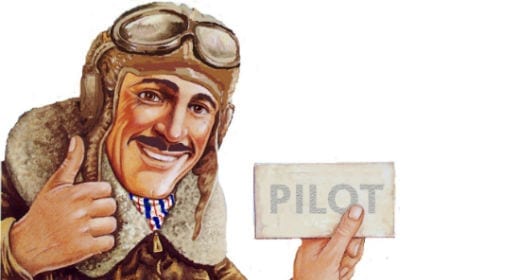
Air Facts Podcast
Today, the heart of Air Facts is you—the pilot. Whether you’re telling the story or offering thoughtful comments, you have lots of interesting stories to tell. And that’s where this podcast comes in. Each episode, we sit down with Air Facts contributors to learn more about them and to hear the story behind their story.

Navy primary flight training—the instructor had it coming
I was thereHe explained roll control by snapping the stick left and right, causing my helmet to nearly strike the canopy. Then, to define pitch control, he sharply shoved the stick forward to about minus 1G, and hauled it back to about plus 2Gs. At about that point, straight ahead, a towering cumulus cell loomed up. We could have banked steeply right or left to avoid it but Morris chose a different path.

Danger lurks in circling approaches
What I Know About...Let us not forget that the circling approach maneuver is designed as a last resort, non-precision approach. A circling approach is one that, by dwindling numbers and its inherent design, forces the pilot(s) into a seldom used and high-risk evolution–often migrating us to an unexpected and seldom visited zip code of the threat/error management neighborhood.

Multiple mistakes were too much to overcome
I Can't Believe I Did ThatThe airplane suddenly was blown to the right of centerline by a strong gust. I immediately put in left aileron and worked the rudder to get back to centerline. Just as abruptly the gust was gone, and I felt a sensation that I had not felt before in an aircraft. The left wing simply stopped flying – as if there was no lift at all. This did not develop like any stall I had ever experienced.

From the archives: What it takes to fly the President
Air Facts ArchivesAir Force One, as the Presidential plane is identified when the Chief Executive is aboard, is a swept-wing Boeing VC-137C, basically the same design as the 707-320B, an intercontinental jetliner flown by many airlines. Delivered in late 1962, it has a top speed of 620 miles-an-hour, and a non-stop range of 7000 miles — 2500 miles more than the previous Presidential jet.

From the archives: long distance pilot Max Conrad
Air Facts ArchivesIn this trip through the archives, we're republishing an article from the November 1965 edition of Air Facts. Here, regular contributor Neil Armstrong profiles "the Maestro of Flight—Max Conrad." If the name sounds familiar it's because he set numerous flying records in the 1950s and 1960s, most of them in general aviation airplanes.

The right pilot mindset: realistic, not conservative
John's blogYou’ve heard the cliche: flying isn’t dangerous, it’s just unforgiving. The unforgiving nature of aviation has serious consequences, which we should remember every time we sit in the left seat. The stakes are simply higher than in almost any other part of life, so our day-to-day risk management tools are not enough.

Wolfgang Langewiesche on pilot proficiency
Air Facts ArchivesWe're diving into the Air Facts archives for another thought-provoking article from legendary pilot and author Wolfgang Langewiesche. In "A Ladder to Climb," which first appeared in the August 1970 edition of Air Facts, he argues that pilots need to step up their game and offers a suggestion for how they might do that—with a nod to the world of gliders. Might this be easier with modern technology?

Pilot-induced oscillations: are you a sinner or a victim?
OpinionYou have probably seen this before: a GoPro video showing a pilot struggling with large inputs on the yoke, giving the throttle a hard time with either high thrust or idle power, and after a fair amount of time focused on that demanding approach, a smooth touchdown followed by a reassuring smile. On the title of the video, something mentioning a high crosswind component, and below, the comments saying that the pilot nailed it like a boss. Did he or she?

High mountain flying course: it takes more than a pilot license and a plane
I was thereOur first stop of the day would be Granby, Colorado (GNB) to visit the headwaters of the mighty Colorado River. This was the first leg of a flight that would demonstrate what I had learned in an eight-hour ground school at Western Air Flight Academy as part of a High Mountain Flying Course.

What it takes to be one sharp pilot: pragmatic
Dick's blogPragmatic. That does sound like a pretty good flying plan for private aviation. I say that because our flying is unscripted and flexible as opposed to, for example, airline flying which is anything but unscripted and flexible and is not always based on practical considerations.

What it takes to be one sharp pilot, part four: realistic
Dick's blogIn this off-again on-again series I have touched on awareness, intelligence and coordination. Those are all important. Being realistic also sounds like part of a plan for flying. The first thing that comes to mind is the extremely tired old saw about knowing your (or your airplane’s) limitations. In fact, that has been said with evangelical zeal so many times that, with this mention, I am going to leave it behind.

What it takes to be one sharp pilot, part three: coordination
Dick's blogOperating a private airplane has come to require more and more coordination as time has passed. In the good old days, coordination was thought of mainly in relation to the use of the elevator, ailerons, rudder and power. Now it has become a matter of getting all your stuff together before a flight and keeping it together until the airplane is secured after the flight. Multitasking might be a better word for that.

Top 10 articles of 2015 at Air Facts
HistoryWe had 76 different pilots write for Air Facts over the past 12 months. Almost all of these were just regular pilots who had a story, tip or opinion to share, but they brought an incredibly diverse range of experiences and perspectives. In closing out the year, we thought readers might enjoy a look back at our top 10 most popular articles.

Is coordinating the use of gizmos to control stick, rudder, pitch and power really flying?
Dick's blogBefore you accuse me of throwing gasoline on a fire, I’ll say up front that is exactly what I am doing. The airplane, it seems, has become almost secondary. It is this that has sparked the debate. Is the tail wagging the dog?

What it takes to be one sharp pilot, part two: intelligence
Dick's blogWhen contemplating a smoking hole made by an airplane, “That was a dumb mistake” is a frequent pronouncement. I think that is misleading because I am not aware of any smart mistakes, especially in airplanes. It just takes a relatively high level of native (as opposed to educated on things other than flying) intelligence to perform well as a pilot.

What it takes to be one sharp pilot – start with awareness
Dick's blogHere is a list of the things that I think define a sharp pilot. This is based on well over 50 years of studying general aviation accidents, the theory being that sharp pilots don’t crash. I put "aware" first.

An evening alone
I was there“Lights, camera, action!” I recite to no one but me. It’s my final mantra before takeoff in my Cavalier. Nav and strobe lights on, transponder to ALT, and power up to go. Gladys, my instructor, taught me that.

This is why you became a pilot
OpinionOK, so after a year or so of lessons, studying, agonizing over the written, sweating during the oral and dreading the practical, you’ve done it! You are a pilot! Now what? What do you do with this very rare right and privilege?

I really felt like a pilot when…
John's blogThe 172 touched down at I69, just another Cessna making a landing at this busy flight training airport. But this flight was different, and this Cessna hadn't come from the practice area. In fact, as I taxied N51766 to the ramp, I felt a sense of accomplishment I had never experienced before. This was the end of a 1600 mile journey from California to Cincinnati--and I really felt like a pilot.
